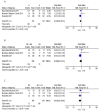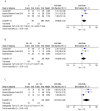Single Nucleotide Polymorphisms in Vitamin D Receptor Gene Affect Birth Weight and the Risk of Preterm Birth: Results From the "Mamma & Bambino" Cohort and A Meta-Analysis
- PMID: 30150529
- PMCID: PMC6164379
- DOI: 10.3390/nu10091172
Single Nucleotide Polymorphisms in Vitamin D Receptor Gene Affect Birth Weight and the Risk of Preterm Birth: Results From the "Mamma & Bambino" Cohort and A Meta-Analysis
Abstract
The effect of vitamin D receptor gene (VDR) polymorphisms on adverse pregnancy outcomes-including preterm birth (PTB), low birth weight and small for gestational age-is currently under debate. We investigated 187 mother-child pairs from the Italian "Mamma & Bambino" cohort to evaluate the association of maternal VDR polymorphisms-BsmI, ApaI, FokI and TaqI-with neonatal anthropometric measures and the risk of PTB. To corroborate our results, we conducted a meta-analysis of observational studies. For the FokI polymorphism, we showed that gestational duration and birth weight decreased with increasing number of A allele (p = 0.040 and p = 0.010, respectively). Compared to the GG and GA genotypes, mothers who carried the AA genotype exhibited higher PTB risk (OR = 12.049; 95% CI = 2.606⁻55.709; p = 0.001) after adjusting for covariates. The meta-analysis confirmed this association under the recessive model (OR = 3.67, 95%CI 1.18⁻11.43), and also pointed out the protective effect of BsmI polymorphism against the risk of PTB under the allelic (A vs. G: OR = 0.74; 95%CI 0.59⁻0.93) and recessive (AA vs. GG + AG: OR = 0.62; 95%CI 0.43⁻0.89) models. Our results suggest the association between some maternal VDR polymorphisms with neonatal anthropometric measures and the risk of PTB.
Keywords: birth cohort; gestational duration; pregnancy; vitamin D.
Conflict of interest statement
The authors declare no conflict of interest.
Figures







Similar articles
-
Maternal-fetal vitamin D receptor polymorphisms significantly associated with preterm birth.Arch Gynecol Obstet. 2017 Aug;296(2):215-222. doi: 10.1007/s00404-017-4412-y. Epub 2017 Jun 13. Arch Gynecol Obstet. 2017. PMID: 28612095
-
Association between vitamin D plasma concentrations and VDR gene variants and the risk of premature birth.BMC Pregnancy Childbirth. 2019 Dec 31;20(1):3. doi: 10.1186/s12884-019-2671-2. BMC Pregnancy Childbirth. 2019. PMID: 31892349 Free PMC article.
-
Vitamin D receptor polymorphism FokI is associated with spontaneous idiopathic preterm birth in an Israeli population.Eur J Obstet Gynecol Reprod Biol. 2014 Jun;177:84-8. doi: 10.1016/j.ejogrb.2014.03.008. Epub 2014 Mar 15. Eur J Obstet Gynecol Reprod Biol. 2014. PMID: 24702903
-
Association of vitamin D receptor gene polymorphism with the risk of renal cell carcinoma: a meta-analysis.J Recept Signal Transduct Res. 2014 Dec;34(6):463-8. doi: 10.3109/10799893.2014.919593. Epub 2014 May 19. J Recept Signal Transduct Res. 2014. PMID: 24840096 Review.
-
Vitamin D receptor gene polymorphisms and the risk for female reproductive cancers: A meta-analysis.Maturitas. 2015 Jun;81(2):256-65. doi: 10.1016/j.maturitas.2015.03.010. Epub 2015 Mar 21. Maturitas. 2015. PMID: 25882760
Cited by
-
Impact of maternal dietary carbohydrate intake and vitamin D-related genetic risk score on birth length: the Vitamin D Pregnant Mother (VDPM) cohort study.BMC Pregnancy Childbirth. 2022 Sep 7;22(1):690. doi: 10.1186/s12884-022-05020-3. BMC Pregnancy Childbirth. 2022. PMID: 36071390 Free PMC article.
-
Corona disease anxiety and health related behaviors: What happened to primgravida women post COVID-19?Sci Afr. 2023 Mar;19:e01528. doi: 10.1016/j.sciaf.2022.e01528. Epub 2022 Dec 30. Sci Afr. 2023. PMID: 36597507 Free PMC article.
-
Nutrient intakes and telomere length of cell-free circulating DNA from amniotic fluid: findings from the Mamma & Bambino cohort.Sci Rep. 2022 Jul 8;12(1):11671. doi: 10.1038/s41598-022-15370-9. Sci Rep. 2022. PMID: 35804173 Free PMC article.
-
The Impact of the COVID-19 Pandemic on Dietary Patterns of Pregnant Women: A Comparison between Two Mother-Child Cohorts in Sicily, Italy.Nutrients. 2022 Aug 17;14(16):3380. doi: 10.3390/nu14163380. Nutrients. 2022. PMID: 36014886 Free PMC article.
-
Effects of Maternal Vitamin D Levels on Prematurity: Feasibility Study in a Multicenter Observational Pilot.Nutrients. 2025 Mar 27;17(7):1160. doi: 10.3390/nu17071160. Nutrients. 2025. PMID: 40218918 Free PMC article.
References
-
- Chiavaroli V., Castorani V., Guidone P., Derraik J.G., Liberati M., Chiarelli F., Mohn A. Incidence of infants born small- and large-for-gestational-age in an italian cohort over a 20-year period and associated risk factors. Ital. J. Pediatr. 2016;42:42. doi: 10.1186/s13052-016-0254-7. - DOI - PMC - PubMed
Publication types
MeSH terms
Substances
LinkOut - more resources
Full Text Sources
Other Literature Sources
Medical

